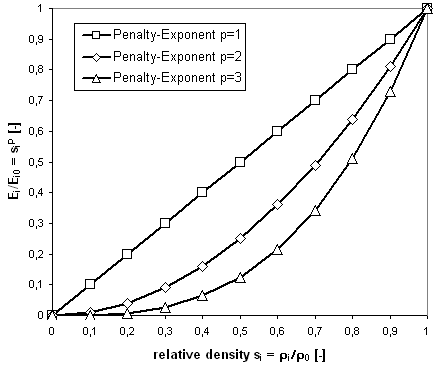Parameters for Standard Linear Static Topology Optimization | ||
| ||
Increments of Volume Modification (SPEED)
The user can specify a speed level for modifying the element properties
in the topology optimization. Per default, the number of iterations is
set to a fixed number of 15. The increments for the volume modification
are calculated implicitly. The control of the element properties modification
is defined with the SPEED parameter where the user,
depending on the objective function and selected constraint, can choose
between the speed levels VERY_SLOW, SLOW, MODERATE, MEDIUM, FAST
and ITER (default set to 15).
For example:
OPT_PARAM
ID_NAME = optimization_control
OPTIMIZE = id_of_optimize
SPEED = SLOW
...
END_
The definition "SPEED=ITER, <number_of_iterations>
" sets the number of iterations (to 15 cycles by default). The number
of iterations can be increased manually or decreased to a minimum number
of ten iterations. A reduction in the number of iterations can lead to
undesired effects in the optimization.
Topologically identical means that the number and configuration of trusses can be slightly different, depending on the starting values and the optimization parameters. The resulting structures have the same stiffness (the sum of the strain energy is almost equal for the different results).
Volume Reduction in First Iteration (START_DELETE)
This option can only be used if the speed is not set to "SPEED=ITER".
By default, more than 5% of the optimization element group volume is removed in
the first iteration of Tosca Structure.topology.
Depending on the model being optimized, increasing this starting value
might accelerate the optimization. This can be done without influencing
the solution, especially, for models where relatively low stresses
are present in large areas. The value is changed using the START_DELETE parameter. The volume to be at least removed in the first iteration
is specified either by the absolute value as in:
START_DELETE = ABS, 200
or by the relative value as in:
START_DELETE = PERC, 0.2
- Too many elements might be removed in the first iteration if the starting value is too high. Tosca Structure.topology might not be able to identify the original force flux if the distribution of forces changes significantly, and the corresponding elements may consequently be deleted.
- If A is the value provided by
START_DELETEand B is a function of the iteration variable, the volume to be removed in the first iteration is A+B(iter). That is why one cannot expect the volume change between first two iterations to be A. - Changing the default settings might in some circumstances lead to coarse structures due to a higher optimization speed.
Relation between Relative Density and Stiffness
In topology optimization, the given mass is distributed within the design area. During this iterative process, elements with the original mass coexist with the original stiffness. But elements also exist that have no mass and no stiffness as well as elements with an intermediate mass and an unknown stiffness. For these elements, the relation between density and stiffness must be determined. Several methods can be found in publications determining this relation. One of the most common is the SIMP approach (Simple Isotropic Material with Penalization) which can be reduced to a simple exponential relation between density and the stiffness of an element.
 |
in this case with |
with as material stiffness tensor of the original material of density and as material stiffness tensor of the unknown material with the corresponding density .
This relation was very controversial but it has proven to be successful in practice. In 1999, BENDSØE and SIGMUND have presented the physical theoretical proof for the penalty exponents and for materials with a lateral contraction coefficient .
For the integrated algorithms, the penalty factor can be modified
using the OPT_PARAM command. Tosca Structure
uses values between 2 and 3 as the default values depending on the algorithms.
OPT_PARAM
ID_NAME = optimization_control
OPTIMIZE = id_of_optimize
...
MAT_PENALTY = 2.5
audience="internal"> POWER_LAW_EXP = 2.5
...
END_